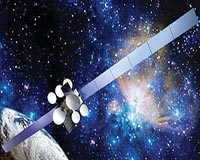 |
Paris, France (ESA) Jan 08, 2010 On 10th December 1999, e2v Charge Coupled Device (CCD) imaging sensors were launched into space onboard Ariane 5 on the European Space Agency's (ESA) x-ray Multi-Mirror Mission (XMM-Newton) X-ray observatory satellite. In its decade of operation the Space telescope has supplied masses of new data which has widened our knowledge of the universe. The satellite itself carries six instruments which are equipped with e2v CCDs: The observatory has three imaging instruments called European Photon Imaging Cameras (EPIC), two of which were built by the University of Leicester. These each use seven e2v CCD22s, optimised for the application, which image extremely weak x-ray radiation and also detect the energy to each photon absorbed. It also has two Reflection Grating Spectrometers (RGS) built by the Space Research Organisation of the Netherlands (SRON), which gives greater precision on detected photon energy. Each instrument uses nine e2v CCD15s which are back illuminated for maximum soft x-ray Quantum Efficiency (QE). Finally it has an Optical Monitor (OM) built by MSSL using an e2v CCD02. This is a conventional but very sensitive optical/UV monitor, which can observe simultaneously the same regions as the x-ray telescopes, but in the ultraviolet and visible wavelengths. Since Earth's atmosphere blocks out all x-rays, only a space telescope can detect and study celestial x-ray sources and help scientists solve cosmic mysteries. XMM-Newton's large collecting area and the ability to make long uninterrupted exposures provides highly sensitive observations; providing data that has furthered understanding of black holes, galaxy clusters, dark matter and the atmosphere of Mars, to name a few. The large amounts of new data collected inspire more than 300 journal articles each year and it is estimated that 2,000 scientists routinely use XMM data (20% of all professional astronomers worldwide). Although now in its 10th year of operation, the satellite is still in excellent condition and is said to have another 10 years of life ahead of it. Brian McAllister, General Managing of Imaging at e2v said "We are delighted to be celebrating XMM-Newton's 10th anniversary and the part that e2v imaging sensors have played in its success. The satellite has been vital in learning more about our universe and, with plenty more to study, looks set to continue to be an important source of data for astronomers for many years to come."
Share This Article With Planet Earth
Related Links XMM-Newton Space Technology News - Applications and Research
 Boeing-Built DirecTV 12 Satellite Delivers 1st Signals From Space
Boeing-Built DirecTV 12 Satellite Delivers 1st Signals From SpaceEl Segundo CA (SPX) Dec 30, 2009 Boeing has received the first on-orbit signals from DirecTV 12 nine hours after launch, indicating that the satellite is healthy and operating normally. DirecTV 12 is a Boeing 702 commercial satellite that will provide consumer television programming to millions of U.S. households. DirecTV 12 lifted off on an International Launch Services Proton Breeze M vehicle on Dec. 28 at 4:22 p.m. Pac ... read more |
|
| The content herein, unless otherwise known to be public domain, are Copyright 1995-2009 - SpaceDaily. AFP and UPI Wire Stories are copyright Agence France-Presse and United Press International. ESA Portal Reports are copyright European Space Agency. All NASA sourced material is public domain. Additional copyrights may apply in whole or part to other bona fide parties. Advertising does not imply endorsement,agreement or approval of any opinions, statements or information provided by SpaceDaily on any Web page published or hosted by SpaceDaily. Privacy Statement |